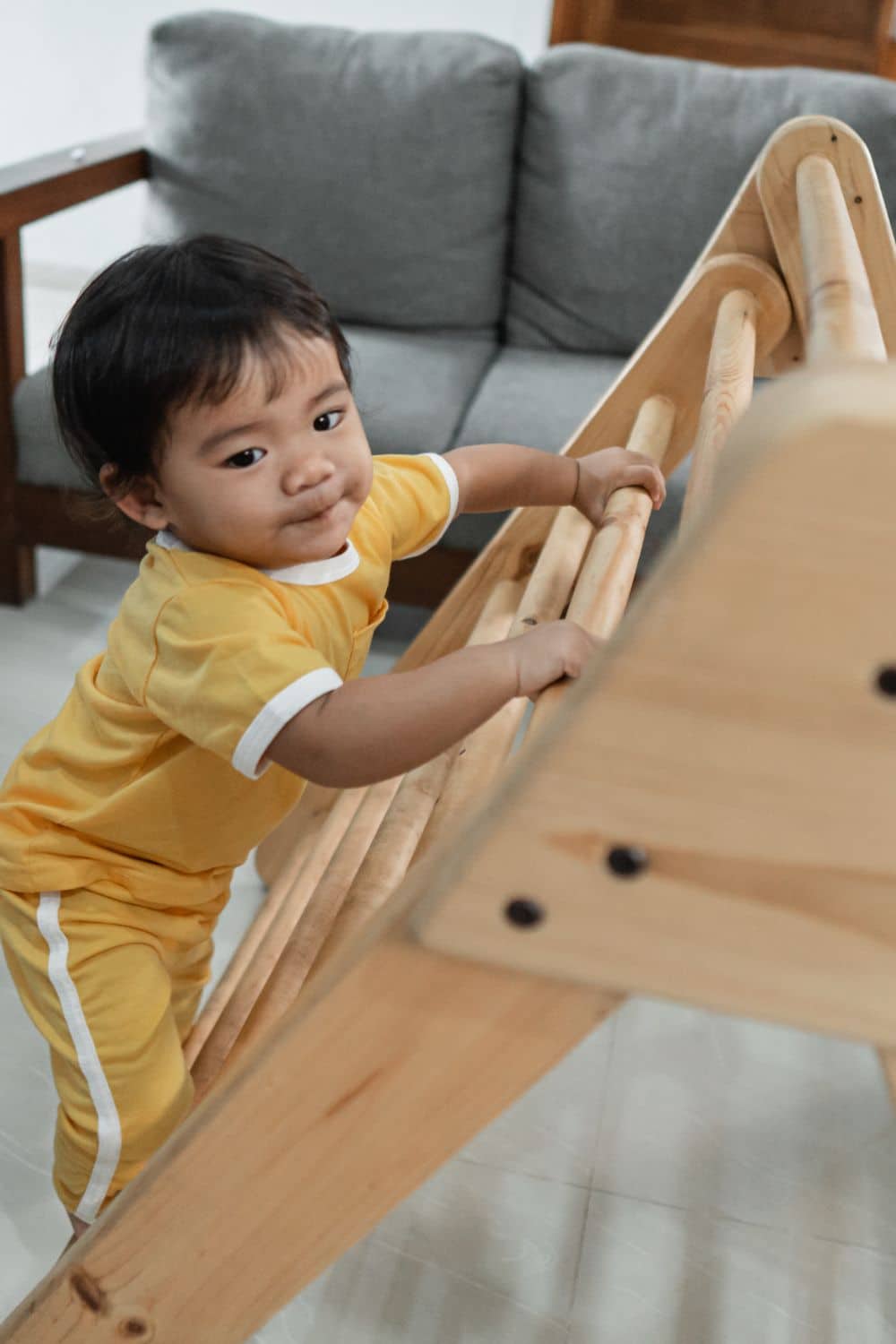Are you looking for some fun Montessori ideas to help promote learning? Check out some pinkler triangle activities and play ideas.
Pikler Triangle Activities and Play Ideas
The pikler triangle set is a beloved Montessori material that promotes learning through creative, child-led play. This sturdy wooden climbing structure enables safe exploration of movement and spatial awareness in children under 3 years old.
Beyond physical skills, the triangle’s open-ended design allows for cognitive, social-emotional, and sensory learning across developmental domains. With some guidance and observation from teachers, the humble pikler triangle can enrich children’s learning and growth through active, imaginative play.
Benefits of the Pikler Triangle
This multi-functional piece of playground equipment has numerous benefits for early learning and development:
- Gross motor skills – Climbing, crawling, balancing and maneuvering promote coordination.
- Problem-solving – Discovering how to navigate the structure builds spatial reasoning.
- Confidence – Safely conquering physical challenges encourages independence.
- Social skills – Taking turns on the triangle and playing cooperatively builds relationships.
- Language development – Describing play activities expands vocabulary and narrative.
- Sensory exploration – The smooth wooden surface offers tactile stimulation.
With advantages spanning physical, mental and social-emotional growth, the triangle set enriches learning through child-directed play.
Setting Up a Pikler Play Space
To enable fulfilling play experiences, teachers should thoughtfully prepare the play environment. Use soft foam tiles or mats under the triangle for safety, avoiding concrete or wood floors. Allow ample open space around the triangle for maneuvering and activities. Initially position the tallest side against a wall for stability when children first start climbing.
If using multiple triangle units, secure them together to prevent spreading apart. Have children remove shoes to allow toe gripping while climbing, with socks on to prevent slippery feet. Keep close adult supervision at all times to minimize injury risk and observe play themes.
With this attentive setup, the pikler triangle can provide a safe, developmentally rich environment for active exploration.
Starting Play: Physical Skills
When first introducing the pikler triangle, focus on building core physical abilities:
- Climbing – Foster climbing skills by demonstrating ascending and descending on hands and knees.
- Crawling – Weave tunnels between units to practice cross-lateral crawling and coordination.
- Balancing – Traverse the sides while maintaining balance, turning around at peaks.
- Jumping – Hop between platforms to build leg strength and body control.
- Stepping – Walk along sides, high-stepping over the cross bars to improve accuracy.
- Scooting – Sit at the top platform and scoot down backward on the bottom to develop core strength.
The triangle’s graduated steps offer the ideal heights and inclines for mastering age-appropriate movement milestones through repetitive practice.
Building on Physical Skills
As children gain competence, introduce more complex activities. Linking multiple triangles together can encourage inventing climbing circuits. Throwing games can be integrated by having children drop softballs or bean bags into buckets placed on platforms. Movement pretend play allows children to pretend to be different animals climbing, like slithering up like a snake or hopping like a frog.
Paired play activities include carrying stuffed animals up the triangle or working with a friend to get balls across it. Ring toss improves visual tracking and hand-eye coordination by having children toss rings onto the triangle points. Relay races make a fun group activity where children pair up and take turns climbing up, going across, and coming down the triangles.
These physical feats now become part of imaginative games that build cognitive, social and emotional skills.
Language and Sensory Play
Verbal creativity, sensory exploration, and scientific observation can also be integrated:
- Commentating play – Narrate children’s play activities out loud to expand vocabulary.
- Imaginative scenarios – Pretend the triangle is a mountain, rocket ship, or castle using props.
- Sensory descriptions – Encourage describing the textures, colors, sounds, and smells during play.
- Nature observations – Place plants or leaves at different heights and observe with magnifying glasses.
- Echo play – Call out phrases and listen to the echoes when under the triangles.
- Shadow play – Notice triangle shadow shapes changing as the sun moves during the day.
Language development and sensory awareness flourish when paired with the triangle’s inviting play space.
Fostering Development Across Domains
Across activities, teachers can also target development in specific areas:
- Physical – Use triangle play to improve balance, coordination and core strength.
- Cognitive – Incorporate counting, puzzles and memory games involving the triangle.
- Language – Ask questions and expand children’s vocabulary for describing play experiences.
- Emotional – Praise perseverance and problem-solving when they encounter physical challenges.
- Social – Encourage turn-taking and sharing the equipment to build cooperation.
Careful observation during triangle play reveals emerging abilities across developmental domains to inform teaching practices.
A Child-Led Approach
The key when using the pikler triangle set is allowing a toddler’s natural curiosity to guide play, rather than dictating rigid activities. Provide opportunities, then step back and observe. Flowing between physical feats, pretend scenarios, sensory exploration and language engagement, the children’s imaginations and abilities will blossom in their own unique ways. The unscripted play offers the richest learning.
The humble wooden triangle provides endless possibilities – climbing wall, dinosaur jungle, reading nook, superhero headquarters, the ideas are limitless. Tuning into play themes reveals children’s emerging capabilities, interests and learning processes. By following the child’s lead, the pikler triangle becomes whatever they need it to be on the day for developing abilities across developmental domains through the sheer joy of play.


Leave A Reply!